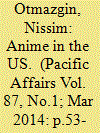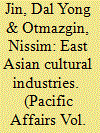| Srl | Item |
| 1 |
ID:
128476


|
|
|
|
|
| Publication |
2014.
|
| Summary/Abstract |
In the past two decades, the enthusiastic global reception of Japanese cultural exports has drawn wide academic attention. In the case of Japanese animation ("anime"), its penetration into the United States, the world's biggest media market, has been described as owing greatly to the crucial role of fans as cultural agents, the deterritorializing effects of globalization, the domestication and heavy editing of anime to suit local tastes, and being part of the wider global flow of Japanese pop culture and "soft power." Drawing on interviews with Japanese and American key personnel in the anime industry, field research and market surveys, this paper focuses on the organizational aspect of the anime market in the United States since the mid-1990s, with particular attention to the role of entrepreneurs, who are imperative for bridging organizational rigidities and cultural differences in global markets. The central argument presented is that entrepreneurship is a central feature in the process of transnational penetration, distribution, reproduction and consumption of cultural commodities and genres, which produce ever more complex and disjunctive economic, cultural and political orders.
|
|
|
|
|
|
|
|
|
|
|
|
|
|
|
|
| 2 |
ID:
128475


|
|
|
|
|
| Publication |
2014.
|
| Summary/Abstract |
This special section is to explore several key issues related to the development in three of the biggest East Asian cultural industries, namely in China, Japan, and South Korea. It addresses a few important dimensions of change that merit analysis-the emergence of East Asian cultural industries in terms of growths in scale and exports; the transnationalization of production and distribution; the relaxation of foreign ownership restraints; and changing relations between the cultural industries and the state. The attempt is to conceptualize the relations between the cultural industries and cultural policy; draw insights from critical media studies and cultural policy studies; and explore what it means for policy-makers when culture and creativity move from the margins to the center of economic activity.
|
|
|
|
|
|
|
|
|
|
|
|
|
|
|
|